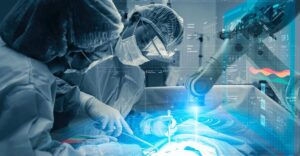
The realm of medicine is experiencing a groundbreaking transformation, fueled by the convergence of technology and healthcare. At the forefront of this revolution is the integration of robotics, a field that brings together precision engineering and medical expertise to enhance patient care, surgical procedures, and diagnostics. In this blog, we delve into the remarkable world of robotics in medicine, exploring how these cutting-edge technologies are redefining precision and driving progress in the realm of healthcare.
- A Robotic Revolution Unveiled: Reshaping Medicine
Robotics in medicine is not science fiction—it’s a reality that’s reshaping the medical landscape. Robotic systems are enhancing the capabilities of healthcare professionals and expanding the possibilities of what medicine can achieve.
- Precision Redefined: Surgical Precision at a Microscopic Scale
Robotic surgical systems are designed to offer unparalleled precision. With the assistance of robotics, surgeons can perform intricate procedures with greater accuracy, minimizing invasiveness and improving patient outcomes.
- Minimally Invasive Mastery: Advancing Laparoscopic Surgery
Robotic technology has propelled minimally invasive surgery to new heights. Robotic-assisted procedures enable surgeons to work through tiny incisions, reducing pain, scarring, and recovery time for patients.
- Remote Surgery: Bridging Geographical Barriers
Telemedicine takes a quantum leap with robotics. Surgeons can now perform surgeries on patients located miles away, leveraging advanced robotic systems to bridge geographical barriers and provide expert care.
- Precise Diagnosis: Robotics in Imaging and Diagnostics
Robotics has expanded its reach into medical imaging and diagnostics. Robotic imaging systems enable precise and targeted scans, aiding in early detection and accurate diagnosis of medical conditions.
- Rehabilitation Revolution: Robotics and Physical Therapy
In the field of rehabilitation, robotics is transforming the way patients regain mobility and strength. Robotic exoskeletons and devices assist in therapy sessions, optimizing recovery processes.
- Pharmaceutical Advancements: Robot-Assisted Drug Delivery
Robotic technologies are even influencing pharmaceuticals. Robotic systems are being used to handle and deliver medications with extreme precision, ensuring accurate dosages and reducing human errors.
- Training and Education: Virtual Learning with Robots
Medical education benefits from robotics as well. Simulation robots provide medical students and professionals with realistic scenarios for practice, improving skills and confidence before real patient interactions.
- Ethics and Safety: Navigating Challenges
As robotics takes center stage in medicine, ethical considerations arise. Balancing automation with human oversight and addressing potential safety concerns is critical for responsible integration.
- A Collaborative Future: Humans and Robots as Partners
The future of robotics in medicine isn’t about replacing healthcare professionals—it’s about enhancing their capabilities. Collaborative robots (cobots) will work alongside human practitioners, amplifying their expertise and impact.
The marriage of robotics and medicine is a testament to human innovation and the potential of technology to transform lives. Robotics is enhancing precision, expanding medical possibilities, and paving the way for a new era of healthcare that merges human expertise with technological excellence. As we embrace this exciting frontier, let us ensure that the integration of robotics in medicine is guided by ethics, safety, and a commitment to providing patients with the highest level of care—where precision and progress unite to shape a healthier and brighter future for all.





